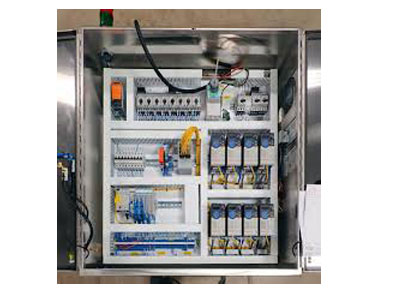What Is A Relay Control Panel?
Key Takeaway
A relay control panel is an electrical assembly that controls and monitors electrical systems and devices using relays. It manages and controls equipment like motors, lights, and other loads. This panel is essential for protection, control, measurement, and monitoring of electrical systems.
The panel contains multiple relays programmed to react to specific inputs or conditions. When an input is received, the relays send power or signals to the connected equipment. Relay control panels are widely used in industrial automation, HVAC systems, manufacturing, water treatment, and utilities. They often come with features like monitoring indicators and control switches to make operation and troubleshooting easier.
Definition and Overview of Relay Control Panels
A relay control panel is an electrical system used to manage and control the operation of various industrial processes. These panels use relays to control circuits and provide a means for manual or automatic operation of machinery. Relay control panels are essential in providing a simple, reliable way to automate and monitor electrical systems.
The core purpose of a relay control panel is to ensure safe and efficient operation by using relay logic to control signals and execute predefined actions. These panels often serve as a backbone for complex control systems in manufacturing and industrial facilities.

Key Components of a Relay Control Panel
Relay control panels are composed of several critical components that work together to ensure smooth operation:
Relays: Electromechanical or solid-state relays that control circuits by opening and closing contacts.
Power Supply: Provides the necessary voltage to power the relays and connected components.
Input Devices: Sensors and switches that send signals to the relay for processing.
Output Devices: Actuators, such as motors and solenoids, that execute the control actions initiated by the relay.
Wiring and Connectors: Essential for interconnecting all components within the panel.
Control Panel Enclosure: Protects the components from dust, moisture, and physical damage.
These components work together to ensure that the relay control panel can perform its functions reliably and efficiently.
Functions and Features of Relay Panels
Relay control panels offer various functions and features that enhance their utility in industrial applications:
Signal Control: Relay panels are capable of sending and receiving electrical signals, allowing for remote operation of machinery.
Safety and Protection: Relay logic can be designed to include safety interlocks that prevent hazardous operations.
Automation: Relay panels facilitate automated control by enabling sequential operation of equipment.
Fault Detection: Some relay panels are designed with built-in fault detection capabilities to identify and alert operators of issues.
Manual and Remote Operation: Relay control panels can be operated manually for testing or overridden by automated systems for routine operations.
These features make relay control panels an indispensable part of modern industrial automation.
Types of Relays Used in Control Panels
Different types of relays are used in control panels based on their specific functions and requirements:
Electromechanical Relays (EMRs): Utilize an electromagnet to move contacts and control circuits. These relays are robust and commonly used in industrial settings.
Solid-State Relays (SSRs): Offer faster response times and increased reliability, as they have no moving parts.
Time-Delay Relays: Introduce time-based control, allowing operations to be delayed for a specific period.
Overload Relays: Protect circuits by breaking the connection when current exceeds a certain threshold.
Latching Relays: Maintain their state until they are reset, providing a way to hold circuits in an ‘on’ or ‘off’ position.
Each type serves a specific purpose and is chosen based on the needs of the application.
Common Applications of Relay Control Panels
Relay control panels find use across various industries due to their versatility and reliability:
Manufacturing: Controlling machinery, conveyor systems, and automated assembly lines.
HVAC Systems: Managing heating, ventilation, and air conditioning operations.
Lighting Control: Automating large-scale lighting systems for energy efficiency.
Pump and Water Treatment Systems: Monitoring and controlling water flow and treatment processes.
Emergency Systems: Ensuring safety protocols are activated during critical situations.
These applications highlight the importance of relay control panels in maintaining operational efficiency and safety in industrial processes.
Conclusion
Relay control panels play a fundamental role in automation systems by providing reliable control and operation of various processes. Understanding their key components, functions, and applications is essential for implementing and maintaining effective control solutions. By utilizing relay control panels, industries can enhance operational efficiency, improve safety, and achieve seamless process automation.

